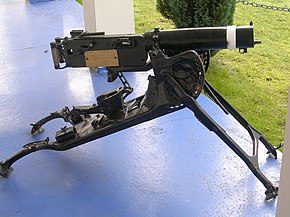Maxim machine gun
| Maxim machine gun | |
|---|---|
| general information | |
| Military designation: | Maxim machine gun |
| Country of operation: | British Empire , United States , German Empire , Switzerland , France , Russian Empire , China , Japanese Empire , Iran , Korea , Ottoman Empire , Italy , Dervish State, Kingdom of Serbia , China , Soviet Union , German Empire 1933 to 1945 , Vichy Regime , Poland , Finland , North Korea , Kingdom of Albania |
| Developer / Manufacturer: | Hiram Maxim, Vickers Limited |
| Manufacturer country: | United Kingdom |
| Production time: | 1889 to 1950 |
| Weapon Category: | Machine gun |
| Furnishing | |
| Overall length: | 1079 mm |
| Weight: (unloaded) | 27.2 kg |
| Barrel length : | 673 mm |
| Technical specifications | |
| Caliber : | .303 British |
| Ammunition supply : | 250 rounds ammunition belt |
| Cadence : | 500-600 rounds / min |
| Fire types: | Continuous fire |
| Twist : | right |
| Visor : | Open sights |
| Closure : | Knee joint closure |
| Charging principle: | Recoil loader |
| Lists on the subject | |
The Maxim machine gun ( French Mitrailleuse Maxim , English Maxim Gun ) was the first self-loading machine gun . It was developed in 1885 by the American-British inventor and designer Hiram Maxim and used until the middle of the 20th century.
In all multi-barrel mitrailleuses developed before the Maxim Gun , such as the Gatling Gun , the De Reffye Mitrailleuse and the Montigny , Gorlow , Nordenfelt and Gardner weapons, bursts of fire were hand-propelled, which exposed the operating team to enemy fire. In addition, there were design-related problems such as heavy weight, unreliability of the system and the cartridge feed.
technology

The Maxim MG developed by Maxim, on the other hand, worked as a recoil loader with a short barrel return and knee-joint lock , it used the recoil of the fired cartridges for the case ejection and reloading process. The ammunition was fed via textile belts, the barrel was water-cooled. Overall, the weapon was considered more reliable than its hand-operated predecessor models. The achievable rate of fire was around 500 rounds per minute. Originally it was used as a light rapid fire gun on a mobile mount , later lighter versions on three-legged frames were developed. Operation, including ammunition feed, required up to 6 men, depending on the model.
Use, versions
Many machine guns of the early 20th century are based on the development of Hiram Maxim, such as the German MG 08 , the MG 08/15 its air-cooled variant MG 08/18, the Russian PM 1910 , the Swiss Mg 1894 and Mg 11 as well as that of Vickers as a successor developed Vickers machine gun (1912).
In 1888, the German colonial force known as the “Wissmann Troop” was the first military unit to be equipped with a Maxim gun for its campaign against the uprising of the East African coastal population . Hermann von Wissmann received one of the first copies of this weapon to reach Germany and used it in his attack on Pangani .
The machine gun was used on a larger scale during the British conquest of Matabeleland in 1893/1894, after it was taken over by the British Army in 1889. It subsequently played an important role in the conquest of the rest of Africa by the European colonial powers. It changed the balance of power and the number of victims in fights between Europeans and Africans decisively in favor of the Europeans. This became clear, for example, at the Battle of Omdurman between the British and Mahdists in Sudan in 1898. Here 9700 African insurgents fell on one side and around 50 British and native allies on the other. The superiority achieved through the introduction in the imperial wars of conquest at the end of the 19th century was often stylized, as the following quote illustrates:
"Whatever happens, we have got
The Maxim gun, and they have not."
"Whatever happens - we have the Maxim machine gun, the others don't."
Manufacturer
For the production of the Maxim machine gun, Maxim founded the Maxim Gun Company , financed mainly by Albert Vickers, the son of steel entrepreneur Edward Vickers , who also became the first president. In 1888, with the support of Rothschild and Vickers , the company merged with its Swedish competitor Nordenfeldt as Maxim-Nordenfeldt Guns and Ammunition Company Limited , based in London. Eventually the company was absorbed into the British Vickers company. In 1896, Vickers secured the patent for the Maxim machine gun. It was initially renamed Maxim-Vickers and, after design changes by Vickers, finally renamed Vickers machine gun . Vickers also exported the weapon to other European countries and America. In the Russo-Japanese War 1904/1905 it was used by both sides.
Maxim MG model 1894, location Morges Military Museum , Switzerland
literature
- Hans Linnenkohl: From a single shot to a fire roller . Bernard & Graefe, Bonn 1990, ISBN 3-7637-5866-6 , p. 15 ff.
Web links
Individual evidence
- ↑ G. Richelmann: creating the Wissmann troops , in: Becker, Perbandt, Richelmann, Schmidt, Steuber: Hermann Wissmann, Germany's largest Africans , Berlin 1907, p 191; here online at archive.org
- ↑ Richelmann p. 236






